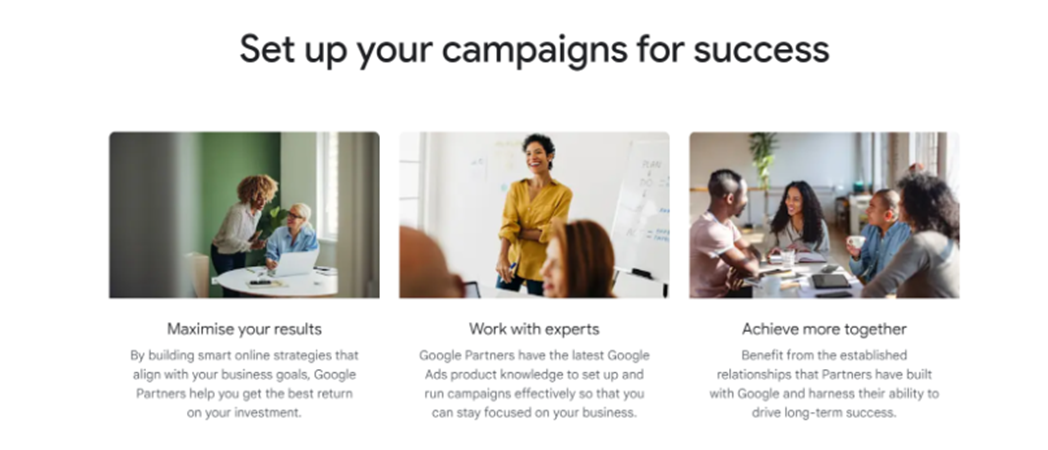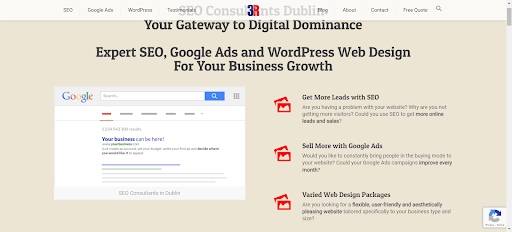
Transforming Google Ads Support: A Strategic Vision for Enhanced Client Success
March 27, 2024
SEO for WordPress in 2024: Vital Tips for Enhanced Performance
April 16, 2024Ad Rank plays a pivotal role in determining both the position of your advertisement on Google’s search results page and the consequent visibility to potential customers. Essentially, it acts as a sorting mechanism that Google uses to decide the order of competing ads. This rank is not static; it’s recalculated each time an ad is eligible to appear and is influenced by a variety of factors including bid amount, ad quality, and the context of the user’s search. Understanding and optimising for Ad Rank can significantly improve your ad’s performance, leading to more clicks, higher conversion rates, and ultimately, a better return on your investment in Google Ads.
Understanding Ad Rank – Essential to Google Ads Success
Ad Rank is a fundamental concept within the realm of Google Ads, serving as the criteria by which Google determines the placement of your advertisements on its search results pages. At its core, Ad Rank is a value that results from the combination of your bid amount, the quality score of your advertisement (a metric that assesses the relevance and usefulness of your ad, landing page, and keywords to the viewer), and the impact of expected clickthrough rates, ad relevancy, and the user experience of the landing page. The higher your Ad Rank, the more favourably your ad is positioned, thus increasing its visibility to potential customers. It’s crucial to grasp that Ad Rank isn’t just about how much you spend but also about the quality and relevance of your ads.
Ad Rank not only determines the order in which advertisements are displayed on the Google search results page but also plays a critical role in whether an ad is shown at all. Essentially, Google uses Ad Rank to conduct a real-time auction every time a search that triggers ads occurs, comparing the Ad Rank values of all competing ads. The ads with the highest Ad Rank not just secure the top positions, thereby gaining maximum visibility, but are also the ones most likely to be displayed. Ads with lower Ad Rank values may not appear at all if they fall below Google’s relevance and quality thresholds. This process ensures that only the most relevant, useful, and high-quality ads are shown to users, optimising the user experience while providing advertisers a fair and competitive platform to showcase their products or services.
If you want to dive into what Google say – check out their support article on Ad Rank.
Understanding the Components of Ad Rank for Google Ads
1. Bid Amount
The bid amount refers to the maximum you are prepared to pay for a click on your ad. It’s a critical component of Ad Rank and plays a substantial role in determining the placement of your advertisement. Essentially, a higher bid can improve your ad’s chance of appearing in a more prominent position on the search results page. However, it’s worth noting that a high bid alone does not guarantee a top position. Google combines the bid amount with factors like ad quality and the expected impact of extensions and other ad formats to govern the overall Ad Rank. This system encourages advertisers to focus not only on how much they spend but also on the quality and relevance of their ads. By optimising ad content and ensuring relevance to the target audience, advertisers can achieve better ad placements even with lower bids, ultimately leading to a more efficient use of their advertising budget.
2. Auction-Time Ad Quality
Expected Clickthrough Rate (CTR)
The likelihood of your ad being clicked, commonly referred to as the Expected Clickthrough Rate (CTR), is a crucial component of the Ad Rank formula. This metric estimates how likely it is that your ad will receive a click when it appears for a specific search query. Google assesses this based on the historical performance of your ad in similar search situations, factoring in elements such as the relevance of your ad’s messaging and the expected user engagement.
A higher Expected CTR indicates to Google that your ad is more relevant and appealing to users, which can positively influence your Ad Rank and therefore enhance the visibility and effectiveness of your campaigns. It is essential for advertisers to continually optimise ad text and landing pages to improve the relevance and attractiveness of their ads, aiming to boost the Expected CTR and achieve better ad positioning on the search results page.
Ad Relevance
Ad Relevance gauges the degree to which your advertisement corresponds to the intent behind a user’s search query. This essential component of Ad Rank assesses how well your ad answers the search query of the user, taking into account factors such as the use of keywords in your ad text and the relevancy of your ad’s content to the search terms. A high level of ad relevance can significantly improve your Ad Rank, as Google aims to provide users with the most useful and relevant search results.
Improving ad relevance involves carefully selecting keywords that match the search terms your potential customers are likely to use and crafting ad text that clearly addresses the needs or questions implied by those searches. Additionally, regularly reviewing and refining your keyword list, and ensuring your ad’s landing page is directly related to the user’s search intent, are crucial steps in enhancing ad relevance. This focus not only boosts your Ad Rank but also contributes to a better overall experience for users, leading to higher click-through rates and more effective ad campaigns.
Landing Page Experience
The Landing Page Experience is a pivotal element in the Ad Rank equation, evaluating how relevant and useful your landing page is to the searcher. This measure considers various factors such as the page’s content quality, ease of navigation, and how quickly the page loads. A positive landing page experience is crucial, as it not only influences your Ad Rank but also has a direct impact on the effectiveness of your advertising efforts. Google favours landing pages that offer clear, helpful, and relevant information tailored to the searcher’s needs, promoting a seamless user experience from ad click to website visit.
Enhancing the landing page experience involves ensuring that the page is directly related to the ad and the search query, providing valuable information or solutions that the user is seeking. Furthermore, a well-optimised landing page should load quickly across devices, boast a user-friendly design, and facilitate easy navigation to encourage user engagement and conversion. By investing in the improvement of your landing page’s relevancy, functionality, and content quality, advertisers can not only boost their Ad Rank but also significantly increase the likelihood of achieving their desired conversion outcomes.
3. Ad Rank Thresholds
Ad Rank Thresholds represent the minimum Ad Rank that an advertisement must achieve to be displayed at a certain position on the search results page. These thresholds are determined by Google and are influenced by various factors, including the user’s search query, the search context, and the specific attributes of the ads competing in the auction. The exact thresholds aren’t publicly disclosed and can vary widely depending on the competitiveness of the keyword and the quality of the ads involved.
Meeting or exceeding these Ad Rank Thresholds is crucial for your ad to be eligible for display. For premium positions at the top of the search results, the thresholds are naturally higher, reflecting the greater visibility and potential impact of these placements. This system ensures that only ads of sufficient quality and relevance attain the most prominent positions, thereby preserving a high-quality user experience.
To improve the likelihood of your ad meeting these thresholds, focus on enhancing the overall Ad Rank through strategies such as optimising the bid amount, increasing the ad’s relevance to search queries, and improving the landing page experience. Remember, achieving a higher Ad Rank not only helps surpass the Ad Rank Thresholds but also can result in more cost-effective ad placements, as Google rewards high-quality ads with better positions and potentially lower costs per click.
4. Search Context
The search context in which an individual’s query is made significantly influences Ad Rank, shaping how ads are prioritised and displayed on the search results page. This context includes factors such as the searcher’s location, the type of device used (such as mobile or desktop), and the time of the search. Each of these elements plays a pivotal role in determining the relevance and, consequently, the ranking of ads presented to the user.
For instance, the location of the searcher can affect ad visibility if an advertiser targets ads to specific geographic areas. Ads that are more pertinent to users in a particular region are likely to achieve a higher Ad Rank when searched from that location. Similarly, device type matters because the user experience differs between desktops and mobile devices; thus, Google adjusts Ad Rank to prioritise ads that offer the best user experience on the specific device being used. Lastly, the timing of the search can also influence Ad Rank, as user intent and engagement can vary throughout the day or week, impacting the competitiveness of certain ads.
Understanding and leveraging the search context allows advertisers to refine their strategies and tailor their ads more closely to the target audience’s immediate circumstances and needs. This adaptability can significantly enhance ad performance by increasing relevance, user engagement, and ultimately, the effectiveness of the ad campaign.
5. Other Ads and Search Results
The competitive landscape of the search results page significantly influences Ad Rank and the overall effectiveness of your ad campaign. This landscape includes not only other advertisements but also organic search results relevant to the user’s query. The type, quality, and positioning of these other elements can affect how your ad is perceived and engaged with by potential customers.
Understanding the ads from competitors that are also vying for attention in the same search space is crucial. A high density of competing ads can increase the required Ad Rank Thresholds, making it more challenging for your ad to secure a prominent position. Similarly, the quality and relevance of these competing ads can influence user expectations and the benchmarks against which your ad is judged.
Furthermore, the presence and ranking of organic search results play a role in how visible and attractive your ad is to users. High-quality, informative organic listings related to the search query can dilute the impact of paid advertisements, as users might be drawn to these “free” resources first. Therefore, it’s essential to consider how your ad complements or stands out from both the paid and organic content on the search results page.
To navigate this competitive environment effectively, advertisers should conduct thorough research on competitor ads and the general content landscape for their key search terms. Strategies such as differentiating ad copy, emphasising unique selling points, and optimising for specific segments of the search context can help your ad capture user attention and achieve better outcomes in the crowded space of the search results page.
6. User Signals and Attributes
User signals and attributes are crucial components that Google takes into account when determining Ad Rank. These factors are based on individual user behaviour and characteristics, providing insight into the likely relevance and effectiveness of an ad to a specific search query. Key user signals include historical search behaviour, past interactions with the advertiser’s ads, and demographic information.
For example, if a user frequently clicks on ads related to digital marketing courses, Google may prioritise ads in this category for future related searches made by that individual. Similarly, if a user has previously interacted with an advertiser’s ads but did not convert, Google might adjust the prominence of that advertiser’s ads in subsequent searches. Demographic factors such as age, gender, and location also influence Ad Rank, as they help Google tailor the ad experience to match the user’s probable interests and needs more closely.
Understanding the impact of these user signals and attributes on Ad Rank underscores the importance of targeting and personalisation in ad campaigns. Advertisers should strive to gather and analyse data on their target audience’s preferences and behaviours to refine their ad targeting strategy.
This can involve using advanced targeting options provided by Google Ads, such as remarketing lists, demographic targeting, and interest-based targeting, to increase the relevance of their ads to individual users. By aligning ad content and targeting with user signals and attributes, advertisers can enhance the chances of their ads achieving higher Ad Ranks and, consequently, better performance in terms of clicks and conversions.
7. Ad Extensions and Formats
Ad extensions and formats play a vital role in enhancing the visibility and functionality of ads, directly influencing Ad Rank and the overall performance of a campaign. These features allow advertisers to provide additional information and interactive elements alongside their standard ad text, making the ad more useful and relevant to potential customers. There are several types of ad extensions available, including site link extensions, callout extensions, structured snippet extensions, and call extensions, each serving a unique purpose.
For example, site link extensions add links beneath the ad copy, directing users to specific pages on a website. This not only makes the ad more prominent on the search results page but also enables users to quickly find the information or product they are interested in. Callout extensions, on the other hand, highlight specific offers or selling points, like free shipping or 24/7 customer support, further persuading users to click on the ad.
Using these extensions effectively can significantly increase an ad’s click-through rate (CTR) and conversion rate by offering users more paths to interaction and more reasons to choose a specific advertiser’s offer. Furthermore, Google’s Ad Rank algorithm considers the expected impact of ad extensions and formats, meaning that well-utilised extensions can lead to higher ad positions and possibly lower cost-per-click (CPC) rates. Advertisers should strategically select and optimise ad extensions that align with their campaign goals and audience’s needs, ensuring that they provide valuable and timely information that enhances the ad’s appeal.
Calculating Ad Rank
The process of calculating Ad Rank entails a combination of factors including the bid amount, ad quality, the competitiveness of the auction, the context of the user’s search, and the expected impact of extensions and formats. To illustrate, consider a simple example where two advertisers are bidding on the keyword “luxury chocolate gifts”.
Advertiser A has a maximum bid of €2.00, with their ad quality scored at 7/10. They utilise site link and callout extensions effectively, which Google estimates will improve their ad’s performance. Advertiser B, on the other hand, has a higher maximum bid of €2.50 but a lower ad quality score of 5/10. They also use ad extensions, but not as effectively as Advertiser A.
To calculate the Ad Rank, Google combines these elements for each advertiser. Although Advertiser B has bid more money, Advertiser A’s better ad quality and more effective use of ad extensions may give them an edge. Suppose Google assigns a value of 1.5 to the expected impact of Advertiser A’s extensions and a value of 1.2 to Advertiser B’s extensions. The Ad Rank would then be computed as follows:
- Advertiser A’s Ad Rank: (€2.00 bid * 7 ad quality score * 1.5 extension impact) = €21.00
- Advertiser B’s Ad Rank: (€2.50 bid * 5 ad quality score * 1.2 extension impact) = €15.00
Despite bidding less, Advertiser A achieves a higher Ad Rank due to superior ad quality and more effective use of ad extensions, potentially earning them a better position on the search results page. This simplified example underscores the importance of balancing bid amounts with the quality and enrichment of your ads through extensions.
Why Ad Rank Matters for Advertisers
Understanding and maintaining a favourable Ad Rank is critical for advertisers seeking to maximise their campaign success on the Google Ads platform. A higher Ad Rank not only enhances the visibility of ads by placing them in more prominent positions on the search results page but also can lead to more cost-efficient campaign performance.
When an ad is positioned higher, it is more likely to be noticed and clicked on by users, increasing the ad’s click-through rate (CTR) and, subsequently, the potential for conversions and sales. This heightened visibility can be particularly beneficial in competitive markets where standing out from rivals is crucial. Additionally, because Google’s Ad Rank algorithm factors in the quality of ads and the use of relevant extensions, achieving a higher rank often means that the ad itself is more relevant and useful to users, further increasing the likelihood of engagement.
Furthermore, a good Ad Rank can lead to a more cost-effective ad spend. Google rewards ads of high quality and relevance with lower cost-per-click (CPC) rates, meaning advertisers can enjoy more clicks for their budget. This efficiency enables advertisers to allocate their budget more effectively across their campaigns, enhancing overall return on investment (ROI).
In essence, prioritising Ad Rank can provide a competitive advantage by improving both the visibility and cost-effectiveness of ads. To achieve this, advertisers must focus on optimising their ad quality, utilising ad extensions judiciously, and refining their targeting to match user intent, ensuring that their campaigns are both compelling to users and well-regarded by Google’s Ad Rank algorithm.
Tips for Improving Ad Rank
Optimising your bidding strategy
This is a crucial aspect of improving Ad Rank and, consequently, the success of your Google Ads campaigns. Here are some strategic considerations for setting competitive bids:
- Understand Your Objectives: Start by clearly defining the goals of your campaign. Whether it’s increasing brand awareness, generating leads, or driving sales, your objective will influence your bidding strategy. For conversions or sales, you may be willing to bid higher, considering the potential return on investment (ROI).
- Conduct Keyword Research: Use tools like Google Keyword Planner to uncover valuable, relevant keywords for your campaign. Understand the average cost-per-click (CPC) for each keyword and assess how they fit into your budget and bidding strategy.
- Utilise Bid Adjustments: Google Ads allows you to adjust bids based on devices, locations, and times of day. For example, if you know that your audience is more likely to convert on mobile devices during evening hours, consider increasing your bids for those circumstances.
- Implement Smart Bidding: Smart Bidding strategies such as Target CPA (Cost Per Acquisition), Target ROAS (Return On Ad Spend), and Enhanced CPC (Cost-Per-Click) leverage Google’s machine learning algorithms to optimise bids for each auction dynamically. These strategies can help improve your Ad Rank by making more informed bidding decisions based on historical data and predicted outcomes.
- Monitor and Adjust Regularly: The competitive landscape of Google Ads is continually changing. It’s crucial to regularly review your bid strategy and adjust based on performance data, competitor actions, and changes in the market.
By thoroughly understanding your campaign objectives, conducting detailed keyword research, and making informed adjustments, you can develop a competitive bidding strategy that enhances your Ad Rank, improves visibility, and maximises the efficiency of your ad spend.
Enhancing Ad Quality
Improving your ad’s quality is vital for achieving a higher Ad Rank and ensuring that your Google Ads campaigns are successful. Here are key strategies to enhance Click-Through Rate (CTR), ad relevance, and landing page experience:
- Optimise Ad Copy: Craft compelling, clear, and concise ad copy that directly speaks to the needs and interests of your target audience. Use strong call-to-actions (CTAs) that encourage users to click through to your site. Test different versions of your ad copy to identify what resonates best with your audience.
- Utilise relevant keywords: Incorporate relevant keywords in your ad copy and headlines to make them more relevant to the user’s search query. This not only improves ad relevance but also helps in boosting your ad’s CTR.
- Improve Landing Page Experience: The landing page experience is a critical factor that Google considers. Ensure that your landing page is directly relevant to your ad and provides a good user experience. This includes fast loading times, mobile optimisation, clear and relevant content, and easy navigation.
- Use Ad Extensions: Ad extensions provide additional information and ways for users to interact with your ad. Utilising site link, callout, structured snippet, and location extensions can make your ad more appealing and useful to potential customers, thereby increasing CTR.
- Targeting and Segmentation: Adjust your targeting settings to ensure your ads are being shown to the most relevant audience. Use demographic, geographic, and device targeting to tailor your ads to users who are most likely to be interested in your product or service.
- A/B Testing: Regularly perform A/B testing on your ads and landing pages. Testing different elements like headlines, descriptions, and call to actions can give you insights into what appeals to your target audience and drives clicks and conversions.
By focussing on these areas, advertisers can significantly enhance the quality of their ads, leading to higher Ad Rank, better visibility, and more efficient use of their budget.
Leveraging Ad Extensions
Ad extensions are a critical tool in the Google Ads arsenal, providing additional information and interactive elements that can make your ads stand out in a crowded marketplace. Here’s how to select and optimise these extensions for maximum impact:
- Assess Your Extension Options: Google offers a variety of ad extensions, each serving different purposes. Before selecting, consider what information would most benefit your potential customers. For instance, if you’re a local business, location extensions can be invaluable. For e-commerce sites, price or promotion extensions might be more relevant.
- Match Extensions with Campaign Goals: Your chosen extensions should align with your campaign objectives. For example, if your goal is to drive phone calls to your business, then call extensions are a must. If you’re focusing on driving traffic to specific product pages, use sitelink extensions to direct users exactly where they need to go.
- Keep Extension Content Fresh: Regularly update your extensions with the most current and relevant information. This could include new offers, the latest products, or special promotions. Fresh, up-to-date content is more likely to engage users and encourage clicks.
- Use Extensions to Stand Out: In competitive markets, ad extensions can provide the edge you need to stand out. Use unique selling points in your callout extensions, or highlight exclusive promotions in your structured snippets. The more value you can convey through your extensions, the better.
- Optimise for Mobile: Many searches are conducted on mobile devices, so ensure your chosen extensions are optimised for these users. For example, message extensions allow mobile users to directly text your business, providing an immediate way to engage while on-the-go.
- Analyse Extension Performance: Just like any aspect of your campaigns, it’s essential to monitor and analyse the performance of your ad extensions. This data can inform adjustments, helping you to refine and optimise for better results over time.
By strategically selecting and diligently optimising ad extensions, advertisers can significantly enhance the visibility and effectiveness of their ads. This not only improves user engagement but also boosts the overall performance of your Google Ads campaigns.
Targeting the Right Context
Effectively tailoring ads to match the search context of potential customers is paramount for achieving success with Google Ads. Understanding the intent behind users’ searches allows advertisers to create more relevant and impactful ad messages. Here are strategies to ensure your ads resonate with the search context:
- Analyse Search Intent: Begin by classifying searches related to your product or service into categories such as informational, navigational, and transactional. This differentiation helps in crafting ads that align with what the user is seeking. For example, for informational searches, focus on providing valuable information or answering questions. For transactional searches, highlight product benefits or promotions.
- Use Keyword Match Types Wisely: Leveraging the right keyword match types is critical in aligning your ads with search intent. Broad match can capture a wide audience but may not always target the desired context. Using phrase match or exact match can help in targeting more specifically, ensuring your ads appear for searches that closely match or are exactly what your potential customers are looking for.
- Adopt Dynamic Keyword Insertion (DKI): DKI allows you to automatically insert keywords from your campaign into your ad text, making your ads more relevant to the user’s search query. This not only improves CTR but also enhances ad relevance as the ad text directly reflects the user’s search query.
- Contextual Targeting for Display Ads: When running display campaigns, use contextual targeting to place your ads on websites related to your product or service. Google’s machine learning can analyse web content to find placements that match the context and themes of your target keywords, aligning your ads with the interests and intent of your audience.
- Tailor Ads to Different Stages of the Buyer’s Journey: Recognise that users at different stages of the buyer’s journey will have varying contexts for their searches. Crafting different ads for awareness, consideration, and decision stages, and targeting them accordingly, can significantly increase the relevance and effectiveness of your campaigns.
- Utilise Audience Targeting: Beyond keywords, use audience targeting options like demographics, interests, and behaviours to further tailor your ads. This allows you to not only target based on what users are searching for but also who they are, adding an additional layer of context to your ads.
By applying these strategies, advertisers can ensure that their ads are not only visible but also distinctly relevant to the search context of their intended audience. This relevance is key to engaging users, driving higher quality traffic, and ultimately, achieving better conversion rates.
Conclusion
In conclusion, the success of Google Ads campaigns hinges on the strategic selection and optimisation of ad extensions, alongside tailoring ad content to the search context of potential customers. Key takeaways include the importance of assessing extension options relevant to your business, matching these extensions with your campaign goals, and keeping the content fresh to enhance user engagement. Additionally, optimising for mobile users and regularly analysing extension performance can provide valuable insights for future campaigns.
Furthermore, understanding users’ search intent and wisely using keyword match types can significantly improve ad relevance and performance. Adopting dynamic keyword insertion and contextual targeting ensures your ads resonate more effectively with the targeted audience. Lastly, tailoring ads to different stages of the buyer’s journey and utilising audience targeting can amplify the relevance and impact of your campaigns. Implementing these strategies can lead to more engaged users, higher quality traffic, and better conversion rates, ultimately maximising the effectiveness of your Google Ads campaigns.
Ongoing Optimisation for Ad Rank Improvement
The process of enhancing your Google Ads doesn’t stop once your ads are live; it’s an ongoing effort to monitor, analyse, and optimise for better Ad Rank and overall performance. Remember, Ad Rank determines your ad’s position on the search results page, and improving it requires constant attention to your ads’ quality score and bid amounts.
Ensuring your ads are highly relevant to user queries, refining landing pages for the best user experience, and adjusting bids to find the ideal balance between cost and visibility are crucial steps. However, it’s also worth considering engaging with a specialist who can bring a wealth of experience and expertise to your campaigns. 3R has been helping SMEs with their Google Ads for over 10 years.
Contact 3R, Your Google Ads Expert
For those looking to truly optimise their campaigns and improve their Ad Rank effectively, enlisting the help of experts can be a game-changer. At 3R, we specialise in Google Ads management, leveraging advanced strategies and insights to enhance your visibility and conversion rates. Our team, as a certified Google partner, is committed to keeping your campaigns at the forefront of digital advertising, ensuring they are not only relevant but highly effective.
Don’t settle for mediocre performance; allow 3R to unlock the full potential of your Google Ads campaigns. Reach out today for a consultation and see how we can help you achieve your advertising goals.




